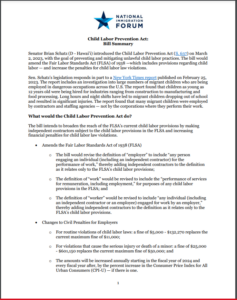 Senator Brian Schatz (D – Hawai’i) introduced the Child Labor Prevention Act (S. 637) on March 2, 2023, with the goal of preventing and mitigating unlawful child labor practices. The bill would amend the Fair Labor Standards Act (FLSA) of 1938 —which includes provisions regarding child labor — and increase the penalties for child labor law violations.
Senator Brian Schatz (D – Hawai’i) introduced the Child Labor Prevention Act (S. 637) on March 2, 2023, with the goal of preventing and mitigating unlawful child labor practices. The bill would amend the Fair Labor Standards Act (FLSA) of 1938 —which includes provisions regarding child labor — and increase the penalties for child labor law violations.
Sen. Schatz’s legislation responds in part to a New York Times report published on February 25, 2023. The report includes an investigation into large numbers of migrant children who are being employed in dangerous occupations across the U.S. The report found that children as young as 12 years old were being hired for industries ranging from construction to manufacturing and food processing. Long hours and night shifts have led to migrant children dropping out of school and resulted in significant injuries. The report found that many migrant children were employed by contractors and staffing agencies — not by the corporations where they perform their work.
What would the Child Labor Prevention Act do?
The bill intends to broaden the reach of the FLSA’s current child labor provisions by making independent contractors subject to the child labor provisions in the FLSA and increasing financial penalties for child labor law violations.
- Amends the Fair Labor Standards Act of 1938 (FLSA)
- The bill would revise the definition of “employer” to include “any person engaging an individual (including an independent contractor) for the performance of work,” thereby adding independent contractors to the definition as it relates only to the FLSA’s child labor provisions;
- The definition of “work” would be revised to include the “performance of services for remuneration, including employment,” for purposes of any child labor provisions in the FLSA; and
- The definition of “worker” would be revised to include “any individual (including an independent contractor or an employee) engaged for work by an employer,” thereby adding independent contractors to the definition as it relates only to the FLSA’s child labor provisions.
- Changes to Civil Penalties for Employers
- For routine violations of child labor laws: a fine of $5,000 – $132,270 replaces the current maximum fine of $11,000;
- For violations that cause the serious injury or death of a minor: a fine of $25,000 – $601,150 replaces the current maximum fine of $50,000; and
- The amounts will be increased annually starting in the fiscal year of 2024 and every fiscal year after, by the percent increase in the Consumer Price Index for All Urban Consumers (CPI-U) — if there is one.
- Changes to Criminal Penalties for Employers
- For repeated or willful violations of child labor laws: a fine up to $50,000, up to a year in jail, or both. Replaces the current maximum fine of $10,000, a maximum of six months’ imprisonment, or both.
- The revised penalties will apply to violations committed on or after the enactment of the bill.
How does the Child Labor Prevention Act respond to reports of unlawful child labor practices?
The Times uncovered a significant issue with potential child labor law violations affecting migrant child workers in recent years. This bill addresses the concerns of rising unlawful child labor practices and enacts more severe penalties to reduce this trend.
- Although the bill addresses the issue of increasing child labor and child labor law violations, Congress must still address the report’s other findings:
- The Department of Health and Human Services (HHS) quickly vets sponsors in some cases and releases migrant children to relatives or individuals who are not their parents, whom the children do not know well. Some of these sponsors mislead the kids into thinking they are going to be enrolled in school and apply pressure on them to obtain full-time work and earn money;
- HHS is directed to check on all minors after a month of living with their sponsors; however, the agency does not have a system in place to ensure it follows up with children if they have lost contact with the department: “over the last two years, the agency could not reach more than 85,000 children,” a sizable number compared with the roughly 130,000 unaccompanied minors who entered the U.S. in 2022; and
- HHS has failed to notice clusters or patterns, in which a high number of unaccompanied children are being released to the same unrelated sponsors — or multiple sponsors — in certain areas suspected of possible mass labor exploitation.
Congress must take steps to ensure HHS has the necessary funding to expand the agency’s post-release services, in ways that continue to support migrant children and keep them connected to services. This includes increasing the number of caseworkers available to adequately follow-up and maintain communication with all minors and their sponsors. Additionally, HHS must do their part to better recognize patterns of labor exploitation that arise in certain areas with a concentrated number of child migrants.
The National Immigration Forum would like to thank Karime Puga, policy and advocacy intern, for developing this bill summary.


